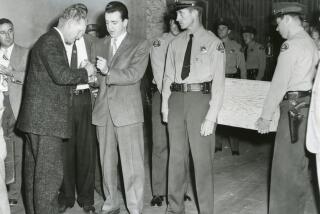The lonely crusade of ‘Longford’
Frank Pakenham, the Earl of Longford, enjoyed a reputation as one of the most vigorous British social reformers of the 20th century -- that is, until he befriended a convicted serial killer who helped her domineering lover sadistically kill their young prey.
The HBO drama “Longford,” which was screened at the Sundance Film Festival and airs Saturday, incisively depicts the complex friendship that developed between the earl and Myra Hindley, considered “the most reviled woman in Britain.” It shows also how their relationship incensed a nation and earned him the nickname “Lord Wrongford.”
“What a pretty smile you have,” the film’s avuncular Longford (Jim Broadbent) tells Hindley (Samantha Morton) at their fateful first meeting in 1968 at London’s Holloway Prison, as other inmates and visitors look on with disgust. That smile contrasts with the unflinching stare the real Hindley gave the police photographer on the day she was arrested, at age 23, near Manchester, in October 1965. She and Ian Brady were tried the following April for killing three minors.
The death penalty having been suspended a few weeks after their arrests, Hindley and Brady were given life sentences. She told Longford there had been no more victims, but in 1987 the pair confessed to killing two other minors. The horrific nature of the so-called Moors murders shook the British public, and the pall hasn’t dwindled with the passing years. In America, perhaps only the Manson killings have equal notoriety -- but their victims weren’t children.
“The Moors murders resonate, I think, because of the age of the victims -- those of other British serial killers ... were almost all adults,” said Duncan Campbell, a senior correspondent with The Guardian, who interviewed Longford several times. “Also there have been relatives of [Brady and Hindley’s] victims who have been prepared to keep in touch with the media.”
Initiated and written by Peter Morgan -- nominated for an Oscar for his script for “The Queen” -- and directed by Tom Hooper, “Longford” doesn’t dwell on Hindley and Brady, as did “See No Evil: The Moors Murders,” a TV movie shown in the Britain last May. The focus is the eccentric aristocrat of the title, a devout Catholic whose unshakable belief in compassion and forgiveness may have clouded his judgment. The film explores this and Hindley’s intellectual seduction of him. She too was a Catholic and seemingly used the faith to impress him with the depth of her apparent remorse.
Though Longford fought for Hindley’s parole for nearly three decades, she would write to Duncan Staff, author of a book about the Moors murders, “Frank has been a pestilential pain in the neck over the years with his ‘campaigning’ and he glories in the publicity himself.” She died of respiratory failure in prison in 2002, surviving Longford by 16 months. The criminally insane Brady will never be released.
A crusading Labour politician and Cabinet minister, Longford began rehabilitating prisoners in the 1930s and continued it into his 90s. As well as Hindley, he visited with other serial killers and some of Britain’s most vicious gangsters. In the 1970s, his anti-pornography campaign earned him another scathing tabloid nickname, “Lord Porn.”
He and his historian wife, Elizabeth, were successful authors; their eight children include the writers Antonia Fraser and Rachel Billington. One scene in the movie shows him hogging the limelight to talk to the media about Hindley at Billington’s book-signing event. Although Elizabeth (Lindsay Duncan) upbraids him for this indiscretion, she eventually befriends Hindley too, just as Lady Longford did in real life.
Broadbent said he didn’t think much of Longford when he first took the role.
“I thought him a buffoon who liked the sound of his own voice and took up contrary positions for the sake of it.” After getting into the role, however, Broadbent said he began to empathize with the character “by understanding how serious he was about his belief that redemption was possible and forgiveness was something to be embraced as an ethical principle. You can’t argue with the core idea of what he was fighting for, but he got it wrong when he didn’t realize he wasn’t doing his cause any good. I think the moral principle was all with him, and everything else took a back seat.”
“Longford often spoke about the need for people in prison to be given hope of redemption, and he also often quoted his Christian beliefs to back up his idea that sinners could repent,” the Guardian’s Campbell says of his conversations with him. “I think he was naive rather than misguided. He did not understand that he might be seen as a gullible old man being manipulated by Hindley. I admired him for taking on lost causes even when they exposed him to ridicule, although I thought his foray into challenging pornography was also naive and allowed people to mock the issue.”
The film throws up issues about prisoners’ rights. Hindley served seven years beyond the minimum 30 when she died.
“I wanted the film to open a debate,” Morgan said. “If you’re going to abandon the death penalty, you run into real problems with someone like Hindley. If a prisoner has served a natural life sentence, do they present a danger to the public? If not, then this person deserves parole. Regardless of what one might feel about Hindley’s crimes, she had undoubtedly become a political prisoner. She was kept in jail because no home secretary would risk the public outcry if he released her. But to be honest, I don’t think she had repented in any shape or form by the end. I think the fascination with what she had done stayed with her.
“As I was writing the script, there was a moment when I got caught up in Longford’s perspective, but there was a day when I really connected with those crimes,” Morgan continued. It was when Andy Serkis, playing Brady, mimicked the cries of the 10-year-old girl he and Hindley tape recorded as they tortured her to death.
Morgan said he subsequently had the film’s Hindley say the line, “Evil can be a spiritual experience too,” when she and Longford meet for the last time. The line came from a source who had visited Hindley over a 15-year period.
“One day, Hindley told her how they had killed one of the children, and she felt that Hindley was so connected still with the excitement of that moment that she decided never to visit her again. Hearing that, I decided, in some private way, that I couldn’t forgive her as well.”
Morton said she wouldn’t have participated in a story told from Hindley’s perspective because “that would have glorified her. She was very cold about what she’d done, though her human rights still should have been taken into account. The law states certain things, but the law decides -- when it suits the law -- to bend them a little, and that’s what I have difficulty with.”
Hooper believes one of Longford’s biggest missteps was in recommending parole for Hindley too early.
“Barely 10 years had passed before he said that on TV while sitting opposite one of the victims’ mothers, who said, ‘When do I get my parole?’ At that moment, his compassion is with the victims of the prison system, not the victims of their crimes. But however flawed his concept of forgiveness was, I wish we all had a bit more of it.”
“Longford will always be associated with asking the British public to forgive a woman they couldn’t forgive,” Morgan said.
More to Read
Only good movies
Get the Indie Focus newsletter, Mark Olsen's weekly guide to the world of cinema.
You may occasionally receive promotional content from the Los Angeles Times.










